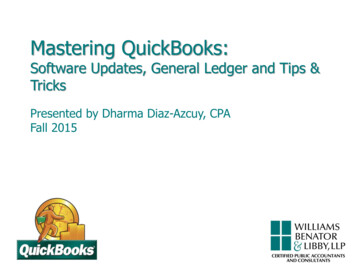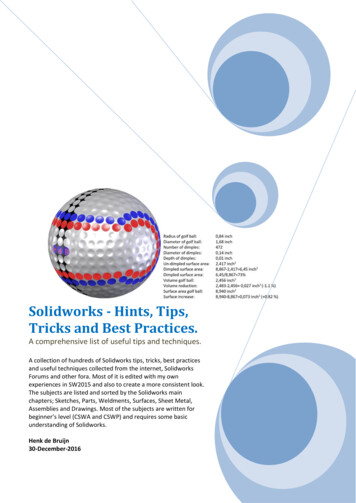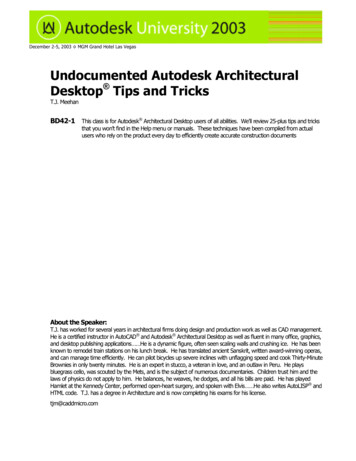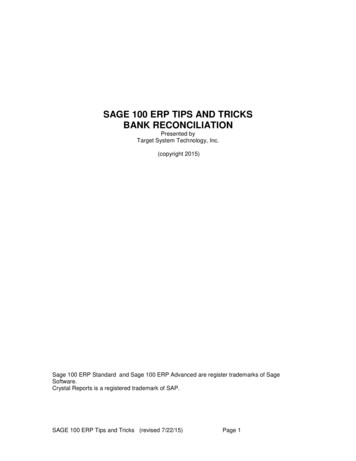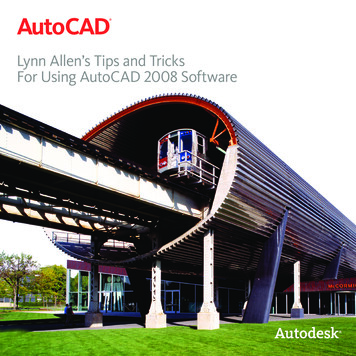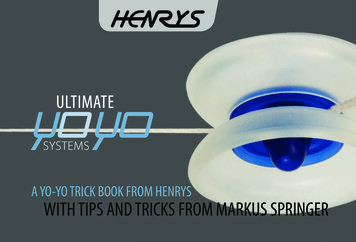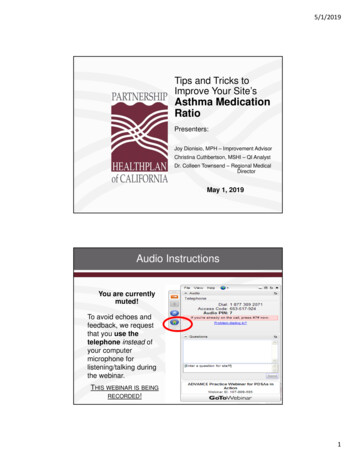
Transcription
5/1/2019Tips and Tricks toImprove Your Site’sAsthma MedicationRatioPresenters:Joy Dionisio, MPH – Improvement AdvisorChristina Cuthbertson, MSHI – QI AnalystDr. Colleen Townsend – Regional MedicalDirectorMay 1, 2019Audio InstructionsYou are currentlymuted!To avoid echoes andfeedback, we requestthat you use thetelephone instead ofyour computermicrophone forlistening/talking duringthe webinar.THIS WEBINAR IS BEINGRECORDED!1
5/1/2019Agenda Why is AMR important?PCP QIP MeasureHEDIS Measure OverviewData tips and tricksClinical significance and best practicesAsthma Medication Ratio (AMR) – WHY IT MATTERS?Asthma is a treatable, reversible condition thataffects more than 25 million people in theUnited States. Managing this condition withappropriate medications could save the U.S.billions of dollars in medical costs.The prevalence and cost of asthma haveincreased over the past decade, demonstratingthe need for better access to care andmedication.Centers for Disease Control and Prevention (CDC). 2011. “CDC Vital Signs: Asthma in theUS.” ns.pdf2
5/1/2019Asthma Medication Ratio (AMR) Rates in PHCPartnership Quality Dashboard 04/09/2019Asthma Medication Ratio (AMR)Measure DescriptionThe percentage of members 5-64 years of agewho were identified as having persistent asthmaand had a ratio of controller medications to totalasthma medications of 0.50 or greater during themeasurement year.Units of Controller Medications AMRRatioUnits of Total Asthma Medications3
5/1/2019PCP QIP – New to Family and Internal MedicineFull PointsPractice TypeFamilyAdult MedicinePediatricTotal Points10 points10 points15 pointsThreshold Percentile62.28%50thDenominatorNumber of members 5-64 years of age who wereidentified as having persistent asthma during themeasurement year and the year prior to themeasurement yearNumeratorNumber of members in the eligible population whohave a medication ratio of 0.5 or greaterAsthma Medication Ratio (AMR)Inclusion into the measurecan be based on any of thefollowing events:Exclusions: Members who had any of thefollowing diagnosis at any time intheir history Outpatient visit or observation visitwhere there was a diagnosis ofasthma and the patient receivedtwo separate asthma dispensingevents. Acute inpatient visits where thepatient received a principaldiagnosis of asthma. ED visits with a principal diagnosisof asthma.Members with no asthmamedications dispensed. Members in hospice. At least four asthma medicationdispensing events. EmphysemaCOPDObstructive Chronic BronchitisChronic Respiratory Conditions dueto fumes/vaporCystic FibrosisAcute Respiratory Failure4
5/1/2019What You Can Do?Tips to improve HEDIS Scores Submit claims and encounter information in a timely manner Ensure patients are accurately diagnosed with persistent asthma Evaluate members before approving requests for refills of rescueinhalers Educate patients on asthma and taking asthma medications correctly,including the proper use of long-term controller medications Community pharmacist as part of care team Use gap lists and prioritize patients with low AMR (e.g. less than 0.50)AMR in eReports5
5/1/2019AMR in eReportsAMR in eReports6
5/1/2019Goals of Asthma TherapyOptimize Quality of Life Symptom controlMaximize functional activityReduce impairmentLimit Risks Acute ExacerbationsEmergency and Urgent Care VisitsHospitalizations and intubationComponents of Managing Asthma Monitoring Symptoms and Lung Function Patient Education Identification and Control of Triggers Pharmacologic Interventions7
5/1/2019Monitoring SymptomsAssessing Symptoms and Risk at Every Visit Query symptoms and function from the last 4 weeksQuery past use of steroids, ED/UC visits,Admissions, and intubationMonitor Pulmonary Function tests Peak Flow Meter – Self ManagementSpirometry: In Office vs LabPatient EducationDisease process SymptomsRisk Factors and lung functionEffects on quality of lifeMedication Purpose and Use Difference between short acting vs controllersInhaler techniqueEmphasis on daily use of controllersAsthma Action Plan Allows patient empowerment though education andself management8
5/1/2019Identify and Manage TriggersSeasonal and Environmental factors Identify and avoid triggersTreat allergies that can not be avoided aggressivelyUpper Respiratory Infections Increase use of inhaled medications, bronchodilators,and steroids at the onset of symptomsVaccinations TDaP every 10 yearsAnnual InfluenzaPneumococcal (Pneumovax 23 )Pharmacologic InterventionsAddressing Acute Symptoms Short Acting BronchodilatorsIncreasing frequency/dosing of inhaledcorticosteroidsUse of a spacerManaging Triggers and Preventing Acute Attacks Antihistamines and Montelukast Inhibitors Inhaled Steroids Long Acting Bronchodilators9
5/1/2019Step Therapy Based on Severity of SymptomsIntermittent Asthma – Step 1 TherapySymptoms less than twice per month, no night wakingno attacks in last 12 months, normal FEV1 Short Acting Bronchodilators alone for symptomcontrol Antihistamines / Nasal Steroids for triggerprevention Consider Low Dose ICSStep Therapy Based on SymptomsPersistent Asthma Steps 2-4Symptoms twice per week or more or using rescue inhalertwice per week or moreStart and Titrate Controller Medications:1. ADD inhaled corticosteroid (ICS)2. ADD Leukotriene Antagonist or theophylline3. ADD Long Acting Bronchodilator (Combination Preferred)4. Titrate dose of ICS as needed to improve control5. Evaluate triggers and treat allergies through out10
5/1/2019Medications included in the AMRFormulary RescueMedications: Albuterol (VentolinHFA, ProAirRespiClick)Non-Formulary RescueMedications: Albuterol (ProventilHFA, ProAir HFA) Levalbuterol(Xopenex HFA)Medications included in the AMRFormulary OralControllers: Montelukast (Singulair) Zafirlukast (Accolate)* Theophylline (Theochron)Non-Formulary OralControllers: Montelukast(Singulair 4mgGranules) Zileuton (Zyflo)* Step Therapy Applies (must try Montelukastfirst)11
5/1/2019Medications included in the AMRFormulary InhaledCorticosteroids(ICS): Beclomethasone (QvarRediHaler) Budesonide (PulmicortFlexhaler) Ciclesonide (Alvesco HFA) Flunisolide (Aerospan) Fluticasone Furoate (ArnuityEllipta) Fluticasone Propionate (FloventDiskus) Mometasone (Asmanex)Non-Formulary OralControllers: FluticasonePropionate(Flovent HFA)**Flovent HFA will no longerbe on formulary as of July 1,2019.Medications included in the AMRFormularyICS/LABACombinations: Fluticasone/Salmeterol (AirduoRespiClick) Fluticasone/Salmeterol (WixelaInhub and Advair Diskus)* Budesonide/Formoterol(Symbicort)** BACombinations: Fluticasone/Salmeterol(Advair HFA) Fluticasone/Vilanterol(Breo Ellipta)*Formulary as of July 1, 2019**Step Therapy Applies (must tryfluticasone/salmeterol first)12
5/1/2019Medications included in the AMRNon-Formulary ICSNebulizing Solution:Non-FormularyBiologics: Omalizumab (Xolair) Mepolizumab (Nucala) Reslizumab (Cinqair) Dupilumab (Duxipent) Benralizumab (Fasenra)Budesonide Neb Solution(Pulmicort)**Formulary for children aged 1-8 yearsImproving AMR Improves Patients OutcomesPrescribing Tips Limit Albuterol Inhaler refills on the prescription sent topharmacy “One and Done” Contact patient to schedule return visit when albuterolrefill is requested from the pharmacy Prescribe controllers for 90 day supply and refills to last 1year - PHC will allow up to a 90 day supply of formularycontroller medications starting July 1, 201913
5/1/2019Improving AMR Improves Patient OutcomesOptimize the use of Integrated Primary Care Teams toOptimize use of medications Use of Pharmacists, RNs, and students for patienteducation especially inhaler use Follow up phone call to assess frequency and use ofInhalers with Standing Orders to step up therapy asneeded Use of AMR list to identify patients in need of follow upand educationUpcoming WebinarsAdvanced Access Advanced Access is designed to establish and refine theempanelment process; optimize care teams; improveclinical outcomes; and increase patient, provider, and staffsatisfaction.Date and Time: 12:00 pm – 1:00 pmApril 24, 2019May 7, 2019May 21, 2019June 4, 2019June 18, s/Quality/Pages/Quality Events.aspx14
5/1/2019Resources PHC Quality Measure uality/Pages/QualityMeasure-Highlights.aspx PCP QIP Portals eReports PQD Email us at ImprovementAcademy@partnershiphp.orgQuestions3015
5/1/2019Evaluations!Please complete your evaluation. Your feedback isimportant to us!3116
Audio Instructions You are currently muted! To avoid echoes and feedback, we request that you use the . Increasing frequency/dosing of inhaled corticosteroids Use of a spacer . (Dulera)** *Form

![[IV‐ADV‐9‐A] Tips and Tricks for Payroll and Human Resources](/img/9/tips-and-tricks-payroll-and-hr.jpg)

